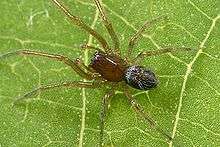Lathys
Lathys is a genus of cribellate araneomorph spiders in the family Dictynidae, and was first described by Eugène Simon in 1884.[3] It is a replacement name for "Lethia" Menge, 1869 because that name was already in use as a synonym for a genus of moths.[4]
| Lathys | |
|---|---|
 | |
| L. insulana, male | |
| Scientific classification | |
| Kingdom: | Animalia |
| Phylum: | Arthropoda |
| Subphylum: | Chelicerata |
| Class: | Arachnida |
| Order: | Araneae |
| Infraorder: | Araneomorphae |
| Family: | Dictynidae |
| Genus: | Lathys Simon, 1884[1] |
| Type species | |
| L. humilis (Blackwall, 1855) | |
| Species | |
|
52, see text | |
| Synonyms[1] | |
Species
As of May 2019 it contains fifty-two species:[1]
- L. adunca Liu, 2018 – China
- L. affinis (Blackwall, 1862) – Madeira, Portugal?
- L. alberta Gertsch, 1946 – USA, Canada, Russia (South Siberia to Far East)
- L. albida Gertsch, 1946 – USA
- L. ankaraensis Özkütük, Marusik, Elverici & Kunt, 2016 – Turkey
- L. annulata Bösenberg & Strand, 1906 – Korea, Japan
- L. bin Marusik & Logunov, 1991 – Russia (Kurile Is.)
- L. borealis Zhang, Hu & Zhang, 2012 – China
- L. brevitibialis Denis, 1956 – Morocco
- L. cambridgei (Simon, 1874) – Israel
- L. changtunesis Hu, 2001 – China
- L. chishuiensis Zhang, Yang & Zhang, 2009 – China
- L. coralynae Gertsch & Davis, 1942 – Mexico
- L. delicatula (Gertsch & Mulaik, 1936) – USA
- L. deltoidea Liu, 2018 – China
- L. dentichelis (Simon, 1883) – Azores, Canary Is.
- L. dihamata Paik, 1979 – Korea, Japan
- L. dixiana Ivie & Barrows, 1935 – USA
- L. fibulata Liu, 2018 – China
- L. foxi (Marx, 1891) – USA
- L. heterophthalma Kulczyński, 1891 – Europe, Russia (Europe to West Siberia)
- L. huangyangjieensis Liu, 2018 – China
- L. humilis (Blackwall, 1855) (type) – Europe to Caucasus and Iran
- Lathys h. meridionalis (Simon, 1874) – Spain, France (mainland, Corsica), North Africa
- L. immaculata (Chamberlin & Ivie, 1944) – USA
- L. inaffecta Li, 2017 – China
- L. insulana Ono, 2003 – Japan
- L. jubata (Denis, 1947) – France
- L. lehtineni Kovblyuk, Kastrygina & Omelko, 2014 – Ukraine, Russia (Europe)
- L. lepida O. Pickard-Cambridge, 1909 – Spain
- L. lutulenta Simon, 1914 – France
- L. maculina Gertsch, 1946 – USA
- L. maculosa (Karsch, 1879) – Korea, Japan
- L. mallorcensis Lissner, 2018 – Spain (Majorca)
- L. maura (Simon, 1911) – Algeria
- L. narbonensis (Simon, 1876) – France, Italy
- L. pallida (Marx, 1891) – USA, Canada
- L. pygmaea Wunderlich, 2011 – Canary Is.
- L. sexoculata Seo & Sohn, 1984 – Korea, Japan
- L. sexpustulata (Simon, 1878) – France, Morocco
- L. simplicior (Dalmas, 1916) – Algeria
- L. sindi (Caporiacco, 1934) – Karakorum
- L. spasskyi Andreeva & Tyschchenko, 1969 – Turkey, Azerbaijan, Kazakhstan, Uzbekistan, Kyrgyzstan, Tajikistan
- L. spiralis Zhang, Hu & Zhang, 2012 – China
- L. stigmatisata (Menge, 1869) – Europe, Turkey
- L. subalberta Zhang, Hu & Zhang, 2012 – China
- L. subhumilis Zhang, Hu & Zhang, 2012 – China
- L. subviridis Denis, 1937 – Algeria
- L. sylvania Chamberlin & Gertsch, 1958 – USA
- L. teideensis Wunderlich, 1992 – Canary Is.
- L. truncata Danilov, 1994 – Russia (Central Asia, South Siberia), Kazakhstan
- L. zhanfengi Liu, 2018 – China
gollark: But with the big text and buttons it seems like it was designed for phones first.
gollark: And it *does* mostly have that.
gollark: And a search button so you can find the right info.
gollark: I mean, I'd hope for a brief description of what it is and a link to a getting started guide, plus relevant-to-everyone information, right at the top of the front page.
gollark: I'm not really a fan of the new meme.market design, it seems like they've gone for style over actual information content.
References
- "Gen. Lathys Simon, 1884". World Spider Catalog Version 20.0. Natural History Museum Bern. 2019. doi:10.24436/2. Retrieved 2019-06-01.
- Lehtinen, P. T. (1967). "Classification of the cribellate spiders and some allied families, with notes on the evolution of the suborder Araneomorpha". Annales Zoologici Fennici. 4: 213–217.
- Simon, E. (1884). "Arachnides nouveaux d'Algérie". Bulletin de la Société Zoologique de France. 9: 321–327.
- Simon, E. (1911). "Catalogue raisonné des arachnides du nord de l'Afrique (1re partie)". Annales de la Société Entomologique de France. 79 (3): 265–332.
External links
- "Lathys" at the Encyclopedia of Life
This article is issued from Wikipedia. The text is licensed under Creative Commons - Attribution - Sharealike. Additional terms may apply for the media files.